数字图像处理实验题目要求
数字图像处理课程设计题目和要求模板

数字图像处理课程设计题目和要求模板数字图像处理课程设计题目和要求12020年4月19日文档仅供参考数字图像处理课程设计内容、要求题目一:图像处理软件1、设计内容及要求:(1)、独立设计方案,实现对图像的十五种以上处理(比如:底片化效果、灰度增强、图像复原、浮雕效果、木刻效果等等)。
(2)、参考photoshop软件,设计软件界面,对处理前后的图像以及直方图等进行对比显示;(3)、将实验结果与其它软件实现的效果进行比较、分析。
总结设计过程所遇到的问题。
2、参考方案(所有参考方案若无特殊说明,均以matlab为例说明):(1)实现图像处理的基本操作学习使用matlab图像处理工具箱,利用imread()语句读入图像,例如image=imread(flower.jpg),对图像进行显示(如imshow(image)),以及直方图计算和显示。
(2)图像处理算法的实现与显示12020年4月19日文档仅供参考针对课程中学习的图像处理内容,实现至少十五种图像处理功能,例如模糊、锐化、对比度增强、复原操作。
改变图像处理的参数,查看处理结果的变化。
自己设计要解决的问题,例如引入噪声,去噪;引入运动模糊、聚焦模糊等,对图像进行复原。
(3)参照“photoshop”软件,设计图像处理软件界面可设计菜单式界面,在功能较少的情况下,也能够设计按键式界面,视功能多少而定;参考matlab软件中GUI设计,学习软件界面的设计。
题目二:数字水印1、设计内容及要求:为保护数字图像作品的知识产权,采用数字水印技术嵌入水印图像于作品中,同时尽可能不影响作品的可用性,在作品版权发生争执时,经过提取水印信息确认作品版权。
一般情况下,水印图像大小要远小于载体图像,嵌入水印后的图像可能遇到噪声、有损压缩、滤波等方面的攻击。
因此,评价水印算法的原则就是水印的隐藏性和抗攻击性。
根据这一要求,设计水印算法。
(1)、查阅文献、了解数字水印的基本概念。
数字图像处理实验报告——图像分割实验

实验报告课程名称数字图像处理导论专业班级_______________姓名 _______________学号_______________电气与信息学院与谐勤奋求就是创新一.实验目得1.理解图像分割得基本概念;2.理解图像边缘提取得基本概念;3.掌握进行边缘提取得基本方法;4.掌握用阈值法进行图像分割得基本方法.二。
实验内容1.分别用Roberts,Sobel与拉普拉斯高斯算子对图像进行边缘检测。
比较三种算子处理得不同之处;2.设计一个检测图1中边缘得程序,要求结果类似图2,并附原理说明。
3.任选一种阈值法进行图像分割、图1 图2三.实验具体实现1.分别用Roberts,Sobel与拉普拉斯高斯算子对图像进行边缘检测。
比较三种算子处理得不同之处;I=imread(’mri、tif');imshow(I)BW1=edge(I,’roberts’);figure ,imshow(BW1),title(’用Roberts算子’)BW2=edge(I,’sobel’);figure,imshow(BW2),title(’用Sobel算子 ')BW3=edge(I,’log’);figure,imshow(BW3),title(’用拉普拉斯高斯算子’)比较提取边缘得效果可以瞧出,sober算子就是一种微分算子,对边缘得定位较精确,但就是会漏去一些边缘细节.而Laplacian—Gaussian算子就是一种二阶边缘检测方法,它通过寻找图象灰度值中二阶过零点来检测边缘并将边缘提取出来,边缘得细节比较丰富。
通过比较可以瞧出Laplacian-Gaussian算子比sober算子边缘更完整,效果更好。
2.设计一个检测图1中边缘得程序,要求结果类似图2,并附原理说明.i=imread('m83、tif’);subplot(1,2,1);imhist(i);title('原始图像直方图');thread=130/255;subplot(1,2,2);i3=im2bw(i,thread);imshow(i3);title('分割结果’);3.任选一种阈值法进行图像分割、i=imread('trees、tif’);subplot(1,2,1);imhist(i);title('原始图像直方图’);thread=100/255;subplot(1,2,2);i3=im2bw(i,thread);imshow(i3);title('分割结果’)1、分别用Roberts,Sobel与拉普拉斯高斯算子对图像进行边缘检测。
《数字图像处理》期末大作业(1)
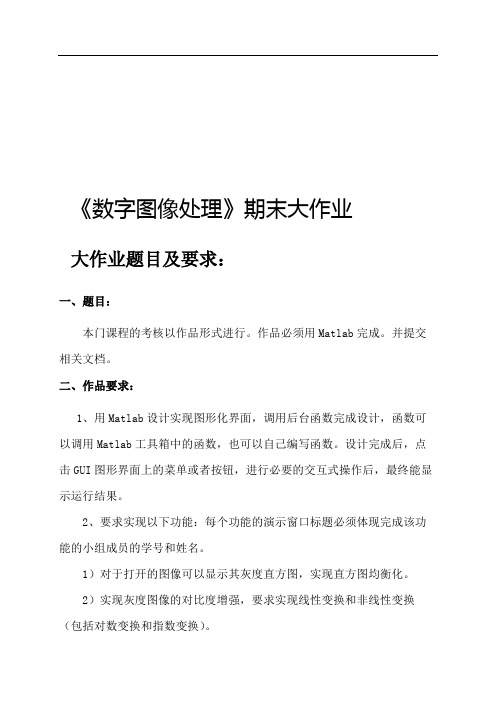
《数字图像处理》期末大作业大作业题目及要求:一、题目:本门课程的考核以作品形式进行。
作品必须用Matlab完成。
并提交相关文档。
二、作品要求:1、用Matlab设计实现图形化界面,调用后台函数完成设计,函数可以调用Matlab工具箱中的函数,也可以自己编写函数。
设计完成后,点击GUI图形界面上的菜单或者按钮,进行必要的交互式操作后,最终能显示运行结果。
2、要求实现以下功能:每个功能的演示窗口标题必须体现完成该功能的小组成员的学号和姓名。
1)对于打开的图像可以显示其灰度直方图,实现直方图均衡化。
2)实现灰度图像的对比度增强,要求实现线性变换和非线性变换(包括对数变换和指数变换)。
3)实现图像的缩放变换、旋转变换等。
4)图像加噪(用输入参数控制不同噪声),然后使用空域和频域进行滤波处理。
5)采用robert算子,prewitt算子,sobel算子,拉普拉斯算子对图像进行边缘提取。
6)读入两幅图像,一幅为背景图像,一幅为含有目标的图像,应用所学的知识提取出目标。
3、认真完成期末大作业报告的撰写,对各个算法的原理和实验结果务必进行仔细分析讨论。
报告采用A4纸打印并装订成册。
附录:报告模板《数字图像处理》期末大作业班级:计算机小组编号:第9组组长:王迪小组成员:吴佳达浙江万里学院计算机与信息学院2014年12月目录(自动生成)1 绘制灰度直方图,实现直方图均衡化 (5)1.1 算法原理 (5)1.2 算法设计 (5)1.3 实验结果及对比分析 (5)2 灰度图像的对比度增强 (5)2.1 算法原理 (5)2.2 算法设计 (5)2.3 实验结果及分析 (5)3 图像的几何变换 (5)3.1 算法原理 (5)3.2 算法设计 (5)3.3 实验结果及分析 (5)4 图像加噪(用输入参数控制不同噪声),然后使用空域和频域进行滤波处理 (5)4.1 算法原理 (5)4.2 算法设计 (6)4.3 实验结果及分析 (6)5 采用robert,prewitt,sobel,拉普拉斯算子对图像进行边缘提取 (6)5.1 算法原理 (6)5.2 算法设计 (6)5.3 实验结果及分析 (6)6 读入两幅图像,一幅为背景图像,一幅为含有目标的图像,应用所学的知识提取出目标 (6)6.1 算法原理 (6)6.2 算法设计 (6)6.3 实验结果及分析 (6)7 小结(感受和体会) (6)1 绘制灰度直方图,实现直方图均衡化1.1 算法原理图像增强是指按特定的需要突出一幅图像中的某些信息,同时,消弱或去除某些不需要的信息的处理方法。
《数字图像处理》期末大作业

《数字图像处理》期末大作业大作业题目及要求:一、题目:本门课程的考核以作品形式进行。
作品必须用Matlab完成。
并提交相关文档。
二、作品要求:1、用Matlab设计实现图形化界面,调用后台函数完成设计,函数可以调用Matlab工具箱中的函数,也可以自己编写函数。
设计完成后,点击GUI 图形界面上的菜单或者按钮,进行必要的交互式操作后,最终能显示运行结果。
2、要求实现以下功能:每个功能的演示窗口标题必须体现完成该功能的小组成员的学号(后三位)。
1)对于打开的图像可以显示其灰度直方图,实现直方图均衡化和直方图匹配(规定化)。
2)实现灰度图像的对比度增强,要求实现线性变换和非线性变换(包括对数变换和指数变换)。
3)实现图像的缩放变换、旋转变换等。
4)图像加噪(用输入参数控制不同噪声),然后使用空域和频域进行滤波处理。
5)采用robert算子,prewitt算子,sobel算子,拉普拉斯算子对图像进行边缘提取。
6)读入两幅图像,一幅为背景图像,一幅为含有目标的图像,应用所学的知识提取出目标。
3、认真完成期末大作业报告的撰写,对各个算法的原理和实验结果务必进行仔细分析讨论。
报告采用A4纸打印并装订成册。
附录:报告模板《数字图像处理》期末大作业班级:小组编号:组长:小组成员:浙江万里学院计算机与信息学院2013年12月目录(自动生成)1 绘制灰度直方图,实现直方图均衡化和直方图匹配(规定化)1.1 算法原理1.2 算法设计1.3 实验结果及对比分析图1 ××××××图2 ××××××分析***********************************************2 灰度图像的对比度增强2.1 算法原理2.2 算法设计2.3 实验结果及分析3 图形的几何变换3.1 算法原理3.2 算法设计3.3 实验结果及分析4 图像加噪(用输入参数控制不同噪声),然后使用空域和频域进行滤波处理4.1 算法原理4.2 算法设计4.3 实验结果及分析5 采用robert,prewitt,sobel,拉普拉斯算子对图像进行边缘提取5.1 算法原理5.2 算法设计5.3 实验结果及分析6 读入两幅图像,一幅为背景图像,一幅为含有目标的图像,应用所学的知识提取出目标6.1 算法原理6.2 算法设计6.3 实验结果及分析7 小结(感受和体会)(英文版)Two regulations promulgated for implementation is in the party in power for a long time and the rule of law conditions, the implementation of comprehensive strictly strategic plan, implementation in accordance with the rules and discipline to manage the party, strengthen inner-party supervision of major initiatives. The two regulations supporting each other, the < code > adhere to a positive advocate, focusing on morality is of Party members and Party leading cadres can see, enough to get a high standard; < rule > around the party discipline, disciplinary ruler requirements, listed as "negative list, focusing on vertical gauge, draw the party organizations and Party members do not touch the" bottom line ". Here, the main from four square face two party rules of interpretation: the first part introduces two party Revised regulations the necessity and the revision process; the second part is the interpretation of the two fundamental principles of the revision of laws and regulations in the party; the third part introduces two party regulations modified the main changes and needs to grasp several key problems; the fourth part on how to grasp the implementation of the two regulations of the party. < code > and < Regulations > revised the necessity and revised history of the CPC Central Committee the amendment to the Chinese Communist Party members and leading cadres honest politics several guidelines > and < Chinese Communist Party discipline and Punishment Regulations > column 1 by 2015 to strengthenparty laws and regulations focus. Two party regulations revision work lasted a Y ears, pooling the wisdom of the whole party, ideological consensus, draw historical experience, respect for the wisdom of our predecessors, which reflects the unity of inheritance and innovation; follow the correct direction, grasp the limited goals, adhere to the party's leadership, to solve the masses of the people reflect a focus on the problem. The new revision of the < code > and < rule >, reflects the party's 18 and the eighth session of the third, the spirit of the fourth plenary session, reflecting the experience of studying and implementing the General Secretary Xi Jinping series of important speech, reflects the party's eighteen years comprehensive strictly practice. (a) revised two regulations of the party need of < the ICAC guidelines > in < in 1997 Leaders as members of the Communist Party of China clean politics certain criteria (Trial) > based on revised, the promulgation and implementation of January 2010, to strengthen the construction of the contingent of leading cadres play an important role. But with the party to manage the party strictly administering the deepening, has not been able to fully meet the actual needs. Content is too complicated, "eight prohibition, 52 are not allowed to" hard to remember, and also difficult to put into practice; the second is concisely positive advocated by the lack of prohibited provisions excessive, no autonomy requirements; the third is banned terms and discipline law, both with the party discipline, disciplinary regulationsrepeat and Criminal law and other laws and regulations repeat; the fourth is to "clean" the theme is not prominent, not for the existing problems, and is narrow, only needle of county-level leading cadres above. < rule > is in 1997 < Chinese Communist Party disciplinary cases (Trial) > based on revision, in December 2003 the promulgation and implementation, to strengthen the construction of the party play very important role. Along with the development of the situation, which many provisions have been unable to fully meet the comprehensive strictly administering the practice needs. One is Ji law, more than half of the provisions and criminal law and other countries laws and regulations Repetition; two is the political discipline regulations is not prominent, not specific, for violation of the party constitution, damage the authority of Party Constitution of misconduct lack necessary and serious responsibility to pursue; third is the main discipline for the leading cadres, does not cover all Party members. Based on the above situation, need to < the criterion of a clean and honest administration > and < rule > the two is likely to be more relevant regulations first amendment. By revising, really put the authority of Party discipline, the seriousness in the party tree and call up the majority of Party members and cadres of the party constitution of party compasses party consciousness. (II) two party regulations revision process the Central Committee of the Communist Party of China attaches great importance to two regulations revision . Xi Jinping, general books recorded in the FifthPlenary Session of the eighth session of the Central Commission for Discipline Inspection, on the revised regulations < > made clear instructions. According to the central deployment, the Central Commission for Discipline Inspection from 2014 under six months begin study two regulations revision. The Standing Committee of the Central Commission for Discipline Inspection 4 review revised. Comrade Wang Qishan 14 times held a special meeting to study two regulations revision, amendment clarifies the direction, major issues of principle, path and target, respectively held a forum will listen to part of the province (area) secretary of the Party committee, Secretary of the Discipline Inspection Commission, part of the central ministries and state organs DepartmentThe first party committee is mainly responsible for people, views of experts and scholars and grassroots party organizations and Party members. Approved by the Central Committee of the Communist Party of China, on 7 September 2015, the general office of the Central Committee of the Party issued a notice to solicit the provinces (autonomous regions, municipalities) Party, the central ministries and commissions, state ministries and commissions of the Party (party), the General Political Department of the military, every 3 people organization of Party of two regulations revision opinion. Central Commission for Discipline Inspection of extensive solicitation of opinions, careful study, attracting, formed a revised sent reviewers. In October 8 and October 12, Central Committee PoliticalBureau Standing Committee and the Political Bureau of the Central Committee After consideration of the two regulations revised draft. On October 18, the Central Committee of the Communist Party of China formally issued two regulations. Can say, two laws amendment concentrated the wisdom of the whole party, embodies the party. Second, < code > and < Regulations > revision of the basic principles of two party regulations revision work and implement the party's eighteen, ten eight plenary, the spirit of the Fourth Plenary Session of the Eleventh Central Committee and General Secretary Xi Jinping important instructions on the revised < low political criterion > and < Regulations >, highlighting the ruling party characteristics, serious discipline, the discipline quite in front of the law, based on the current, a long-term, advance as a whole, with Bu Xiuding independent < rule > and < rule >. Main principle is: first, adhere to the party constitution to follow. The constitution about discipline and self-discipline required specific, awaken the party constitution of party compasses party consciousness, maintaining the authority of the constitution. General Secretary Xi Jinping pointed out that "no rules, no side round. Party constitution is the fundamental law, the party must follow the general rules. In early 2015 held the eighth session of the Central Commission for Discipline Inspection Fifth Plenary Session of the 16th Central Committee, Xi Jinping again pointed out that constitution is the party must follow the general rules, but also the general rules." the revisionof the < code > and < rule > is Method in adhere to the regulations established for the purpose of combining rule of virtue is to adhere to the party constitution as a fundamental to follow, the constitution authority set up, wake up the party constitution and party rules the sense of discipline, the party constitution about discipline and self-discipline specific requirements. 4 second is to adhere to in accordance with the regulations governing the party and the party. The Party of rule of virtue "de", mainly refers to the party's ideals and beliefs, excellent traditional style. The revised the < code > closely linked to the "self-discipline", insisting on the positive initiative, for all members, highlight the "vital few", emphasized self-discipline, focusing on the morality, and the majority of Party members and the ideological and moral standards. The revised < > Ji method separately, Ji, Ji Y an to Method, as a "negative list", emphasizing the heteronomy, focusing on vertical gauge. Is this one high and one low, a positive reaction, the strict party discipline and practice results transformation for the integration of the whole party to observe moral and discipline requirements, for the majority of Party members and cadres provides benchmarking and ruler. Third, insist on to. In view of the problems existing in the party at the present stage, the main problems of Party members and cadres in the aspect of self-discipline and abide by the discipline to make clearly defined, especially the party's eighteen years strict political discipline and political rules, organization and discipline andto implement the central eight provisions of the spirit against the four winds and other requirements into Disciplinary provisions. Not one pace reachs the designated position, focusing on in line with reality, pragmatic and effective. After the revision of major changes, major changes in the < code > and < rule > modified and needs to grasp several key problems (a) < code > < code > adhere to according to regulations governing the party and party with morals in combination, for at the present stage, the leadership of the party members and cadres and Party members in existing main problems of self-discipline, put forward principles, requirements and specifications, showing Communists noble moral pursuit, reflected at all times and in all over the world ethics from high from low 5 common requirements. One is closely linked to the "self-discipline", removal and no direct relation to the provisions of . the second is adhere to a positive advocate, "eight prohibition" 52 are not allowed to "about the content of the" negative list moved into synchronization amendment < cases >. Three is for all the party members, will apply object from the leadership of the party members and cadres to expand to all Party members, fully embodies the comprehensive strictly required. The fourth is prominent key minority, seize the leadership of the party members and cadres is the key, and put forward higher requirements than the ordinary Party members. Five is to simplify, and strive to achieve concise, easy to understand, easy to remember. The revised < code > is the ruling Party since the first insists ona positive advocate forAll Party members and the self-discipline norms, moral declaration issued to all members of the party and the National People's solemn commitment. > < criterion of a clean and honest administration consists of 4 parts, 18, more than 3600 words. After the revision of the < code >, a total of eight, 281 words, including lead, specification and Party member cadre clean fingered self-discipline norms, etc. Part 3 members low-cost clean and self-discipline, the main contents can be summarized as "four must" "eight code". Lead part, reiterated on ideal and faith, fundamental purpose, the fine traditions and work style, noble sentiments, such as "four must" the principle of requirements, strong tone of self-discipline, The higher request for 6 and supervised tenet, the foothold in permanent Bao the party's advanced nature and purity, to reflect the revised standards requirements. Members of self-discipline norms around the party members how to correctly treat and deal with the "public and private", "cheap and rot" thrifty and extravagance "bitter music", put forward the "four norms". Party leader cadre clean fingered self-discipline norms for the leadership of the party members and cadres of the "vital few", around the "clean politics", from civil servant of the color, the exercise of power, moral integrity, a good family tradition and other aspects of the leadership of the party members and cadres of the "four norms" < > < norm norm. "The Party member's self-discipline norms" and "party members and leading cadre clean fingered self-discipline norms," atotal of eight, collectively referred to as the "eight". "Four must" and "eight" of the content from the party constitution and Party's several generation of leaders, especially Xi Jinping, general secretary of the important discussion, refer to the "three discipline and eight points for attention" statements, and reference some embody the Chinese nation excellent traditional culture essence of epigrams. (2) the revised regulations, the main changes in the revised Regulations > to fully adapt to the strictly requirements, reflects the according to the regulations governing the law of recognition of deepening, the realization of the discipline construction and Jin Ju. < rule > is party a ruler, members of the basic line and follow. And the majority of Party members and cadres of Party organizations at all levels should adhere to the bottom line of thinking, fear discipline, hold the bottom line, as a preventive measure, to keep the party's advanced nature and purity. 1, respect for the constitution, refinement and discipline. Revised < rule > from comprehensive comb physical constitution began, the party constitution and other regulations of the Party of Party organizations and Party discipline requirements refinement, clearly defined in violation of the party constitution will be in accordance with regulations to give the corresponding disciplinary action. The original 10 categories of misconduct, integration specification for political discipline, discipline, honesty and discipline masses Ji Law and discipline and discipline and other six categories, the content of < rule >real return to Party discipline, for the majority of Party members and listed a "negative list. 7 2, highlighting the political discipline and political rules. > < Regulations according to the stage of the discipline of outstanding performance, emphasizing political discipline and political rules, organization and discipline, in opposition to the party's leadership and the party's basic theory, basic line, basic program and basic experience, the basic requirement of behavior made prescribed punishment, increase the cliques, against the organization such as violation of the provisions, to ensure that the central government decrees and the Party of centralized and unified. 3, adhere to strict discipline in the law and discipline In front, Ji separated. Revised < Regulations > adhere to the problem oriented, do Ji separated. Any national law existing content, will not repeat the provisions, the total removal of 79 and criminal law, repeat the content of the public security management punishment law, and other laws and regulations. In the general reiterated that party organizations and Party members must conscientiously accept the party's discipline, die van comply with national laws and regulations; at the same time, to investigate violations of Party members and even criminal behavior of Party discipline and responsibility, > < Regulations distinguish five different conditions, with special provisions were made provisions, so as to realize the connection of Party discipline and state law. 4, reflect Wind building and anti-corruption struggle of the latest achievements. < rule > the party's eighteen yearsimplement the spirit of the central provisions of the eight, against the requirements of the "four winds" and transformation for disciplinary provisions, reflecting the style construction is always on the road, not a gust of wind. In the fight against corruption out of new problems, increase the trading rights, the use of authority relatives profit and other disciplinary terms. Prominent discipline of the masses, the new against the interests of the masses and ignore the demands of the masses and other disciplinary terms and make provisions of the disposition and the destruction of the party's close ties with the masses.Discipline to protect the party's purpose. 8 of these regulations, a total of three series, Chapter 15, 178, more than 24000 words, after the revision of the regulations a total of 3 series, Chapter 11, 133, 17000 words, divided into "general" and "special provisions" and "Supplementary Provisions" Part 3. Among them, add, delete, modify the provisions of the proportion of up to nearly 90%. 1, the general general is divided into five chapters. The first chapter to the regulations of the guiding ideology, principles and scope of application of the provisions, highlight the strengthening of the party constitution consciousness, maintenance the authority of Party Constitution, increase the party organizations and Party members must abide by the party constitution, Y an Centralized centralized, would examine at all levels of the amended provisions implementing and maintaining Party discipline, and consciously accept the party discipline,exemplary compliance with national laws and regulations. The second chapter of discipline concept, disciplinary action types and effects of the regulations, will be a serious warning from the original a year for a year and a half; increase the Party Congress representative, by leaving the party above (including leave probation) punishment, the party organization should be terminated its representative qualification provisions. The third chapter of the disciplinary rules of use prescribed in the discipline rectifying process, non convergence, not close hand classified as severely or heavier punishment. "Discipline straighten "At least eighteen years of five years, these five years is to pay close attention to the provisions of the central eight implementation and anti -" four winds ". The fourth chapter on suspicion of illegal party disciplinary distinguish five different conditions, with special provisions were made provisions, to achieve effective convergence of Party and country 9 method. < rule > the provisions of Article 27, Party organizations in the disciplinary review found that party members have committed embezzlement, bribery, dereliction of duty dereliction of duty and other criminal law act is suspected of committing a crime shall give cancel party posts, probation or expelled from the party. The second is < Regulations > Article 28 the provisions of Party organizations in the disciplinary review But found that party members are stipulated in the criminal law, although not involved in a crime shall be investigated for Party discipline and responsibility shouldbe depending on the specific circumstances shall be given a warning until expelled punishment. This situation and a difference is that the former regulation behavior has been suspected of a crime, the feeling is quite strict, and the latter for the behavior not involving crime, only the objective performance of the provisions of the criminal code of behavior, but the plot is a crime to slightly. < Regulations > the 29 provisions, Party organizations in the discipline review found that party members and other illegal behavior, affect the party's image, the damage to the party, the state and the people's interests, we should depend on the situation Seriousness given disciplinary action. The loss of Party members, seriously damaging the party's image of behavior, should be given expelled from the party. At this article is party member is in violation of the criminal law outside the other illegal acts, such as violates the public security administration punishment law, customs law, financial laws and regulations behavior. The fourth is < cases > Article 32 stipulates, minor party members and the circumstances of the crime, the people's Procuratorate shall make a decision not to initiate a prosecution, or the people's court shall make a conviction and exempted from criminal punishment shall be given within the party is removed from his post, probation or expelled from the party. Party members and crime, sheets were fined in accordance with For acts; the principal Ordinance amended the provisions of the preceding paragraph. This is the new content, in order to achieve Ji method effectiveconvergence. Five is < > the thirty third article 10 of the provisions, the Party member due to an intentional crime is sentenced to criminal law (including probation) sheets or additional deprivation of political rights; due to negligence crime and was sentenced to three years or more (excluding three years) a penalty, shall give expelled punishment. Due to negligence crime is convicted and sentenced to three years (including three years) in prison or be sentenced to public surveillance, detention, shall in general be expelled from the party. For the individual may not be expelled from the party, should control Approval. This is followed and retained the original > < Regulations the provisions of punishment party authorization rules and report to a level party organizations. For is "party members with criminal acts, and by the criminal punishment, generally should be expelled from the party". The fifth chapter of probationary Party member of the discipline and discipline after missing members of the treatment and punishment decisions, such as the implementation of the provisions, clear the related party discipline and punishment decision made after, for duties, wages and other relevant alteration formalities for the longest time. 2, sub sub section will the original regulations of10 categories of acts of violation of discipline integration revised into 6 categories, respectively, in violation of the punishments for acts of political discipline "in violation of discipline behavior of punishment" in violation of integrity of disciplinary action points "of violation punishments for actsof mass discipline" "the violation of work discipline, punishment" in violation of discipline of life behavior punishment "6 chapters. 3, annex" Supplementary Provisions "clear authority making supplementary provisions of, cases of interpretative organ, as well as regulations implementation time and retroactivity etc.. 11 (3) learning understanding > < regulations needs to grasp several key problems The first problem -- about the violation of political discipline behavior > < new ordinance chapter 6 the political discipline column for the six disciplines, that is the main opposition to Party leadership and the opposition of the basic theory, basic line, basic program and basic experience, basic requirements of misconduct made provisions of the disposition, especially the eighteen since the CPC Central Committee put forward the Yan Mingzheng treatment of discipline and political rules requirements and practical achievements transformation for Discipline article, increase the false debate central policies, cliques, against the organization review, make no discipline of the principle of harmony terms. These are the party's eighteen years in comprehensive strictly Process combined with the practice of rich content. (1) false debate the central policies and undermine the Party of centralized and unified the problem is made in accordance with the provisions of the party constitution. Constitution in general programme requirements adhere to democratic centralism is one of the requirements of the construction of the party must adhere to the four cardinal. Applicationof this principle is not only the party the basic organization principle and is also the mass line in party life, it requires that we must fully develop inner-party democracy, respect for the dominant position of Party members, safeguarding the Party member democratic rights, give full play to the enthusiasm and creativity of the party organizations at all levels and Party members, at the same time, also must implement the right concentration, ensure the party's mission < the chaos in unity and concerted action to ensure that the party's decision to get quickly and effectively implementing. The Party Central Committee formulated the major principles and policies, through different channels and ways, fully listen to the party organizations and Party members of the opinions and suggestions, but 12 is some people face to face not to say back blather "" will not say, after the meeting said, "" Taiwan does not say, and nonsense ", in fact, not only disrupt the people thought, some causing serious consequences, the damage to the Party of the centralized and unified, hinder the central policy implementation, but also a serious violation of the democratic system of principles. There is no doubt that shall, in accordance with the Regulations > 4 Specified in Article 6 to give the appropriate punishment. For did not cause serious consequences, to give criticism and education or the corresponding tissue processing. (2) about the destruction of the party's unity < New Regulations > the forty eighth to fifty second article, to damage Party's unity unified and violation of political discipline, punishment situationmade explicit provisions. Article 52 of the new "in the party get round group, gangs seek private gain, cliques, cultivate private forces or through the exchange of interests, for their own to create momentum and other activities to gain political capital, given a serious warning or withdraw from their party posts disposition; if the circumstances are serious, to give Leave a party to observation or expelled from the party. (3) on against the organization review of the provisions of the constitution, party loyalty honesty is party members must comply with the obligations. Members must obey the organization decision, shall not violate the organization decided encounters by asking questions to find organization, rely on the organization, shall not deceive the organization, against the organization. For example, after the investigation does not take the initiative to explain the situation, but to engage in offensive and defensive alliance, hiding the stolen money is against survey organization, is a violation of the behavior of political discipline. Article 24 of the original > < Regulations, although the provisions of the interference, hinder group review the behavior of the fabric can be severely or 13 Aggravated punishment, but did not put this kind of behavior alone as a discipline for qualitative amount of discipline. > < new regulations increase the Article 57, "anti organization review, one of the following acts, given a warning or serious warning; if the circumstances are relatively serious, giving removed from or placed on probation within the party post; if the circumstances are serious, give。
【最新精选】《数字图像处理》结课小论文题目汇总及要求

《数字图像处理》结课测试题目题目的路径:首先在Matlab的Command window中键入“demo”,进入demo 窗口。
然后在树形选择框中选择“Toolboxes\Image Processing”和“Blocksets\ Video and Image Processing”。
最后逐个查看并选择自己感兴趣的题目。
所有题目汇总如下:图像去模糊1. Deblurring Images Using the Blind Deconvolution Algorithm基于盲解卷算法的图像去模糊2. Deblurring Images Using the Lucy-Richardson Algorithm使用LR算法进行图像去模糊3. Deblurring Images Using a Regularized Filter使用正则滤波器进行图像去模糊4. Deblurring Images Using the Wiener Filter使用维纳滤波器进行图像去模糊图像增强5. Contrast Enhancement Techniques图像对比度增强技术6. Correcting Nonuniform Illumination如何对不均匀光照进行校正7. Enhancing Multispectral Color Composite Images多谱(卫星遥感) 图像增强技术图像配准8. Finding the Rotation and Scale of a Distorted Image计算失真图像的旋转参数和尺度参数9. Registering an Aerial Photo to an Orthophoto基于控制点的多幅航拍图像的配准10. Registering an Image Using Normalized Cross-Correlation使用归一化交叉相关法来配准图像图像分割11. Batch Processing Image Files Using Distributed Computing分布式计算对图像序列进行批处理12. Color-Based Segmentation Using the L*a*b* Color Space基于Lab色彩空间的彩色图像分割13. Color-Based Segmentation Using K-Means Clustering 基于K-均值聚类的彩色图像分割14. Detecting a Cell Using Image Segmentation使用图像分割技术来检测细胞15. Finding V egetation in a Multispectral Image多谱图像(卫星遥感)上的农作物区域分割16. Marker-Controlled Watershed Segmentation基于标记控制的分水岭分割算法17. Texture Segmentation Using Texture Filters基于纹理滤波器的纹理图像分割图像几何变换18. Creating a Gallery of Transformed Images常见的图像几何变换简介19. Exploring a Conformal Mapping图像的保角变换(共形映射)20. Extracting Slices from a 3-Dimensional MRI Data Set 如何从3维MRI数据集中提取切片图21. Padding and Shearing an Image Simultaneously图像的剪切变换和填充操作图像的测量22. Finding the Length of a Pendulum in Motion从单摆图像序列中计算摆长23. Granulometry of Snowflakes使用形态学方法对雪花的颗粒度进行测量24. Identifying Round Objects在图像中计算物体的“似圆度”25. Measuring Angle of Intersection在图像中计算钢梁的交叉角度26. Measuring the Radius of a Roll of Tape如何用图像方法测量胶带的半径图像的Radon变换27. Reconstructing an Image from Projection Data基于拉东(Radon)变换的CT图像重建视频检测和跟踪28. Abandoned Object Detection遗弃物体检测技术29. Motion Detection基于SAD的运动检测系统30. Lane Departure Warning System车道偏离预警系统31. Lane Detection and Tracking基于Hough变换的车道检测和跟踪32. Traffic Warning Sign Recognition交通警示牌自动识别技术33. People Tracking基于背景差分的行人检测技术34. Color Segmentation基于色彩分割的人体检测35. Tracking Cars Using Background Estimation 基于背景估计的汽车检测36. Tracking Cars Using Optical Flow基于光流法的汽车检测37. Surveillance Recording基于主帧检测的监控记录技术38. Pattern Matching基于模板匹配的PCB检测系统压缩技术39. V ideo Compression基于DCT变换的视频压缩技术40. Image Compression基于DCT变换的图像压缩技术视频分析技术41. Histogram Display图像直方图的实时显示42. Concentricity Inspection光纤的同心性检测系统43. Edge Detection边缘检测技术简介44. V ideo Focus Assessment视频自动聚焦参量计算视频增强45. V ideo Stabilization基于模板的电子稳像技术46. Periodic Noise Reduction针对周期噪声的图像降噪算法47. Histogram Equalization基于直方图均衡的图像增强48. Rotation Correction基于Hough变换的旋转图像校正基于形态学的视频分割技术49. Cell Counting细胞自动计数系统50. Feature Extraction如何自动计算视频中扇形的数目51. Object Counting如何自动计算订书钉的数目52. Object Extraction and Replacement视频目标的实时提取和替换视频回放处理53. Continuous Image Rotation图像连续旋转效果的实现54. Projecting Videos onto a Rotating Cube 如何将视频投影到旋转的立方体上55. V isual Effects图像浮雕效果的实现56. Picture in Picture画中画效果的实现57. Panorama Creation全景照片技术58. Bouncing Balls如何在图像上叠加动画《数字图像处理》结课测试报告规范1.内容要求(1)本报告(论文)的名字,系统功能、实现了什么结果。
《数字图像处理》结课小论文题目汇总及要求
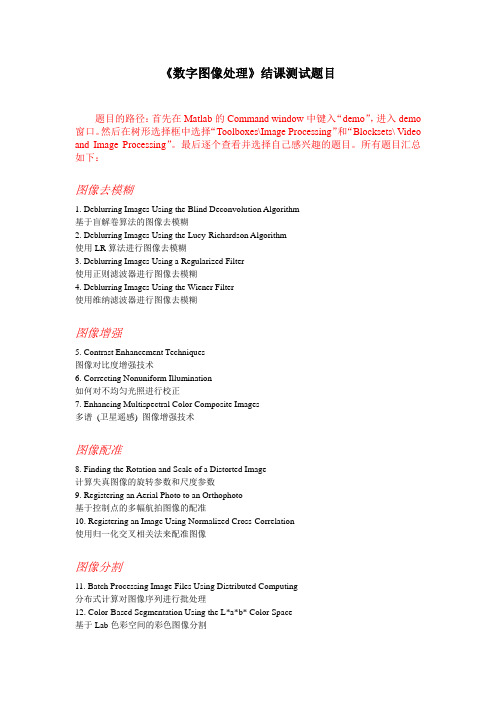
《数字图像处理》结课测试题目题目的路径:首先在Matlab的Command window中键入“demo”,进入demo 窗口。
然后在树形选择框中选择“Toolboxes\Image Processing”和“Blocksets\ Video and Image Processing”。
最后逐个查看并选择自己感兴趣的题目。
所有题目汇总如下:图像去模糊1. Deblurring Images Using the Blind Deconvolution Algorithm基于盲解卷算法的图像去模糊2. Deblurring Images Using the Lucy-Richardson Algorithm使用LR算法进行图像去模糊3. Deblurring Images Using a Regularized Filter使用正则滤波器进行图像去模糊4. Deblurring Images Using the Wiener Filter使用维纳滤波器进行图像去模糊图像增强5. Contrast Enhancement Techniques图像对比度增强技术6. Correcting Nonuniform Illumination如何对不均匀光照进行校正7. Enhancing Multispectral Color Composite Images多谱(卫星遥感) 图像增强技术图像配准8. Finding the Rotation and Scale of a Distorted Image计算失真图像的旋转参数和尺度参数9. Registering an Aerial Photo to an Orthophoto基于控制点的多幅航拍图像的配准10. Registering an Image Using Normalized Cross-Correlation使用归一化交叉相关法来配准图像图像分割11. Batch Processing Image Files Using Distributed Computing分布式计算对图像序列进行批处理12. Color-Based Segmentation Using the L*a*b* Color Space基于Lab色彩空间的彩色图像分割13. Color-Based Segmentation Using K-Means Clustering 基于K-均值聚类的彩色图像分割14. Detecting a Cell Using Image Segmentation使用图像分割技术来检测细胞15. Finding Vegetation in a Multispectral Image多谱图像(卫星遥感)上的农作物区域分割16. Marker-Controlled Watershed Segmentation基于标记控制的分水岭分割算法17. Texture Segmentation Using Texture Filters基于纹理滤波器的纹理图像分割图像几何变换18. Creating a Gallery of Transformed Images常见的图像几何变换简介19. Exploring a Conformal Mapping图像的保角变换(共形映射)20. Extracting Slices from a 3-Dimensional MRI Data Set 如何从3维MRI数据集中提取切片图21. Padding and Shearing an Image Simultaneously图像的剪切变换和填充操作图像的测量22. Finding the Length of a Pendulum in Motion从单摆图像序列中计算摆长23. Granulometry of Snowflakes使用形态学方法对雪花的颗粒度进行测量24. Identifying Round Objects在图像中计算物体的“似圆度”25. Measuring Angle of Intersection在图像中计算钢梁的交叉角度26. Measuring the Radius of a Roll of Tape如何用图像方法测量胶带的半径图像的Radon变换27. Reconstructing an Image from Projection Data基于拉东(Radon)变换的CT图像重建视频检测和跟踪28. Abandoned Object Detection遗弃物体检测技术29. Motion Detection基于SAD的运动检测系统30. Lane Departure Warning System车道偏离预警系统31. Lane Detection and Tracking基于Hough变换的车道检测和跟踪32. Traffic Warning Sign Recognition交通警示牌自动识别技术33. People Tracking基于背景差分的行人检测技术34. Color Segmentation基于色彩分割的人体检测35. Tracking Cars Using Background Estimation 基于背景估计的汽车检测36. Tracking Cars Using Optical Flow基于光流法的汽车检测37. Surveillance Recording基于主帧检测的监控记录技术38. Pattern Matching基于模板匹配的PCB检测系统压缩技术39. Video Compression基于DCT变换的视频压缩技术40. Image Compression基于DCT变换的图像压缩技术视频分析技术41. Histogram Display图像直方图的实时显示42. Concentricity Inspection光纤的同心性检测系统43. Edge Detection边缘检测技术简介44. Video Focus Assessment视频自动聚焦参量计算视频增强45. Video Stabilization基于模板的电子稳像技术46. Periodic Noise Reduction针对周期噪声的图像降噪算法47. Histogram Equalization基于直方图均衡的图像增强48. Rotation Correction基于Hough变换的旋转图像校正基于形态学的视频分割技术49. Cell Counting细胞自动计数系统50. Feature Extraction如何自动计算视频中扇形的数目51. Object Counting如何自动计算订书钉的数目52. Object Extraction and Replacement视频目标的实时提取和替换视频回放处理53. Continuous Image Rotation图像连续旋转效果的实现54. Projecting Videos onto a Rotating Cube 如何将视频投影到旋转的立方体上55. Visual Effects图像浮雕效果的实现56. Picture in Picture画中画效果的实现57. Panorama Creation全景照片技术58. Bouncing Balls如何在图像上叠加动画《数字图像处理》结课测试报告规范1.内容要求(1)本报告(论文)的名字,系统功能、实现了什么结果。
数字图像处理实验题目要求
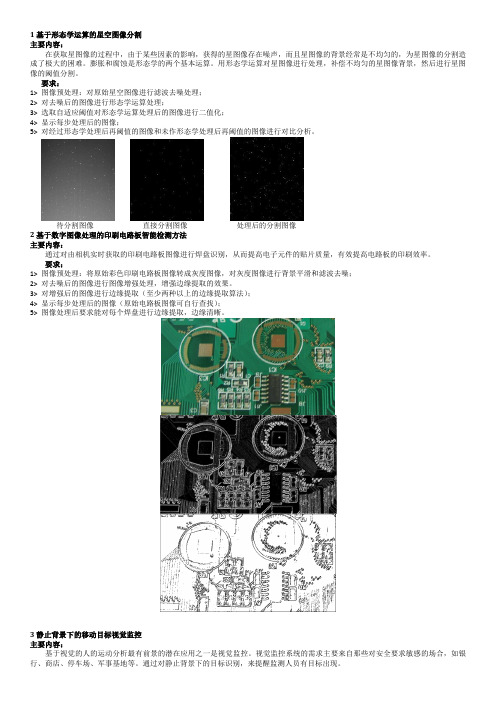
1基于形态学运算的星空图像分割 主要内容:在获取星图像的过程中,由于某些因素的影响,获得的星图像存在噪声,而且星图像的背景经常是不均匀的,为星图像的分割造成了极大的困难。
膨胀和腐蚀是形态学的两个基本运算。
用形态学运算对星图像进行处理,补偿不均匀的星图像背景,然后进行星图像的阈值分割。
要求:1> 图像预处理:对原始星空图像进行滤波去噪处理; 2> 对去噪后的图像进行形态学运算处理;3> 选取自适应阈值对形态学运算处理后的图像进行二值化; 4> 显示每步处理后的图像;5> 对经过形态学处理后再阈值的图像和未作形态学处理后再阈值的图像进行对比分析。
待分割图像 直接分割图像 处理后的分割图像2基于数字图像处理的印刷电路板智能检测方法 主要内容:通过对由相机实时获取的印刷电路板图像进行焊盘识别,从而提高电子元件的贴片质量,有效提高电路板的印刷效率。
要求:1> 图像预处理:将原始彩色印刷电路板图像转成灰度图像,对灰度图像进行背景平滑和滤波去噪; 2> 对去噪后的图像进行图像增强处理,增强边缘提取的效果。
3> 对增强后的图像进行边缘提取(至少两种以上的边缘提取算法); 4> 显示每步处理后的图像(原始电路板图像可自行查找); 5> 图像处理后要求能对每个焊盘进行边缘提取,边缘清晰。
3静止背景下的移动目标视觉监控 主要内容:基于视觉的人的运动分析最有前景的潜在应用之一是视觉监控。
视觉监控系统的需求主要来自那些对安全要求敏感的场合,如银行、商店、停车场、军事基地等。
通过对静止背景下的目标识别,来提醒监测人员有目标出现。
要求:1>对原始参考图和实时图像进行去噪处理;2>对去噪后的两幅图像进行代数运算,找出目标所在位置,提取目标,并将背景置黑;3> 判断目标大小,若目标超过整幅图像的一定比例时,说明目标进入摄像保护区域,系统对监测人员进行提示(提示方式自选)。
数字图像处理课程设计题目和要求-2013
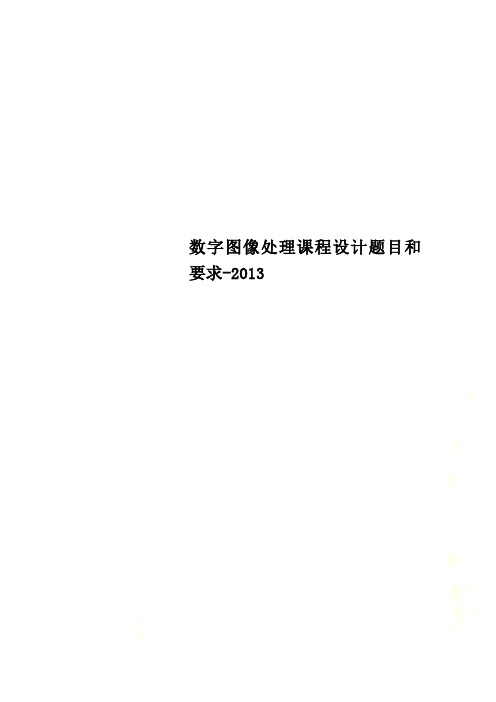
数字图像处理课程设计题目和要求-2013郑州大学(软件技术学院)课程设计报告数字图像处理课程设计内容、要求题目一:图像处理软件1、设计内容及要求:(1)、独立设计方案,实现对图像的十五种以上处理(比如:底片化效果、灰度增强、图像复原、浮雕效果、木刻效果等等)。
(2)、参考photoshop软件,设计软件界面,对处理前后的图像以及直方图等进行对比显示;(3)、将实验结果与其他软件实现的效果进行比较、分析。
总结设计过程所遇到的问题。
2、参考方案(所有参考方案若无特殊说明,均以matlab为例说明):(1)实现图像处理的基本操作学习使用matlab图像处理工具箱,利用imread()语句读入图像,例如image=imread (flower.jpg),对图像进行显示(如imshow郑州大学(软件技术学院)课程设计报告(image)),以及直方图计算和显示。
(2)图像处理算法的实现与显示针对课程中学习的图像处理内容,实现至少十五种图像处理功能,例如模糊、锐化、对比度增强、复原操作。
改变图像处理的参数,查看处理结果的变化。
自己设计要解决的问题,例如引入噪声,去噪;引入运动模糊、聚焦模糊等,对图像进行复原。
(3)参照“photoshop”软件,设计图像处理软件界面可设计菜单式界面,在功能较少的情况下,也可以设计按键式界面,视功能多少而定;参考matlab软件中GUI设计,学习软件界面的设计。
题目二:数字水印1、设计内容及要求:为保护数字图像作品的知识产权,采用数郑州大学(软件技术学院)课程设计报告字水印技术嵌入水印图像于作品中,同时尽可能不影响作品的可用性,在作品版权发生争执时,通过提取水印信息确认作品版权。
通常情况下,水印图像大小要远小于载体图像,嵌入水印后的图像可能遇到噪声、有损压缩、滤波等方面的攻击。
因此,评价水印算法的原则就是水印的隐藏性和抗攻击性。
根据这一要求,设计水印算法。
(1)、查阅文献、了解数字水印的基本概念。
数字图像处理课程设计题目
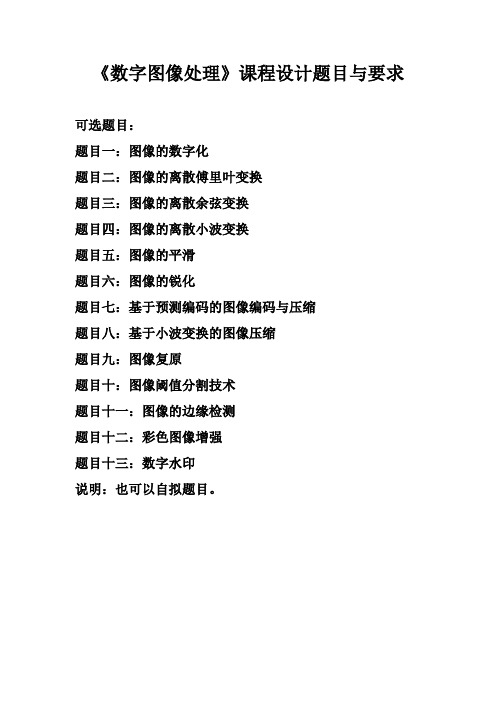
《数字图像处理》课程设计题目与要求
可选题目:
题目一:图像的数字化
题目二:图像的离散傅里叶变换
题目三:图像的离散余弦变换
题目四:图像的离散小波变换
题目五:图像的平滑
题目六:图像的锐化
题目七:基于预测编码的图像编码与压缩
题目八:基于小波变换的图像压缩
题目九:图像复原
题目十:图像阈值分割技术
题目十一:图像的边缘检测
题目十二:彩色图像增强
题目十三:数字水印
说明:也可以自拟题目。
内容要求:
一、课程设计的目的与要求
二、设计的主要内容及基本原理
三、图像编码程序总体方案设计
3.1、图像处理程序流程图
3.2、用MATLAB实现图像处理程序源代码及注释
四、课程设计总结与体会
格式要求:
见考查课课程设计说明书范文
说明:请认真对待、严格按照格式要求书写。
每人各自选一个题目做设计,请独立完成。
内容示例:基于行程编码的图像编码程序设计。
数字图像处理 考试 要求
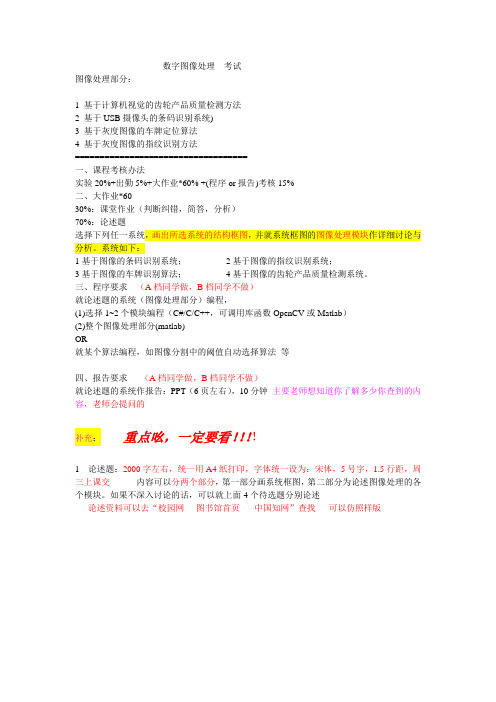
数字图像处理考试图像处理部分:1 基于计算机视觉的齿轮产品质量检测方法2 基于USB摄像头的条码识别系统)3 基于灰度图像的车牌定位算法4 基于灰度图像的指纹识别方法===================================一、课程考核办法实验20%+出勤5%+大作业*60% +(程序or报告)考核15%二、大作业*6030%:课堂作业(判断纠错,简答,分析)70%:论述题选择下列任一系统,画出所选系统的结构框图,并就系统框图的图像处理模块作详细讨论与分析。
系统如下:1基于图像的条码识别系统;2基于图像的指纹识别系统;3基于图像的车牌识别算法;4基于图像的齿轮产品质量检测系统。
三、程序要求(A档同学做,B档同学不做)就论述题的系统(图像处理部分)编程,(1)选择1~2个模块编程(C#/C/C++,可调用库函数OpenCV或Matlab)(2)整个图像处理部分(matlab)OR就某个算法编程,如图像分割中的阈值自动选择算法等四、报告要求(A档同学做,B档同学不做)就论述题的系统作报告:PPT(6页左右),10分钟主要老师想知道你了解多少你查到的内容,老师会提问的补充:重点吆,一定要看!!!!1 论述题:2000字左右,统一用A4纸打印,字体统一设为:宋体,5号字,1.5行距,周三上课交内容可以分两个部分,第一部分画系统框图,第二部分为论述图像处理的各个模块。
如果不深入讨论的话,可以就上面4个待选题分别论述论述资料可以去“校园网----图书馆首页-----中国知网”查找可以仿照样版2A档同学要么做程序,要么做PPT,二选一注意:编程序的同学要带电脑去给老师看,时间:周三下午第一大节的第二小节,请事先充满电吆!!!如果做PPT的同学比较多的话,第八周周二可能要去教室讲,具体等通知,3小提示:数字图像处理时间安排:第八周周一:上机,并交第二次实验报告;第八周周三:第一节课堂测试,开卷;题型:判断题++简答题++分析题第二节:就A档同学做的检查(程序或PPT),并交第三次的实验报告如果仍有疑问,可以找我吆!!! 请大家相互转告吆!!谢谢配合!!。
数字图像处理实验报告
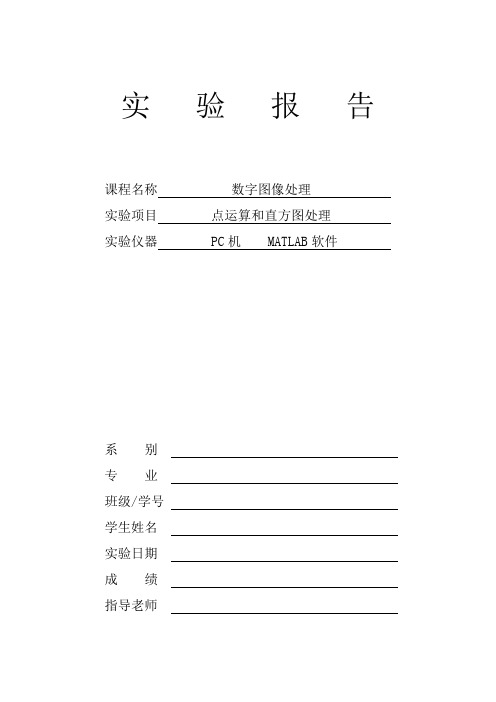
实验报告课程名称数字图像处理实验项目点运算和直方图处理实验仪器 PC机 MATLAB软件系别专业班级/学号学生姓名实验日期成绩指导老师实验1 点运算和直方图处理一、实验目的1. 掌握利用Matlab图像工具箱显示直方图的方法2. 掌握运用点操作进行图像处理的基本原理。
3. 进一步理解利用点操作这一方法进行图像处理的特点。
4. 掌握利用Matlab图像工具箱进行直方图均衡化的基本方法。
二、实验的硬件、软件平台硬件:计算机软件: MATLAB三、实验内容及步骤1. 了解Matlab图像工具箱的使用。
2. 利用Matlab图像工具箱对图像进行点操作,要求完成下列3个题目中的至少2个。
⑴图1灰度范围偏小,且灰度偏低,改正之。
⑵图2暗处细节分辨不清,使其能看清楚。
⑶图3亮处细节分辨不清,使其能看清楚。
图1 图2 图33. 给出处理前后图像的直方图。
4. 利用MatLab图像处理工具箱中函数对以上图像进行直方图均衡化操作,观察结果。
四、思考题1. 点操作能完成哪些图像增强功能?2. 直方图均衡化后直方图为何并不平坦?为何灰度级会减少?五、实验报告要求1.对点操作的原理进行说明。
2.给出程序清单和注释。
3.对处理过程和结果进行分析(包括对处理前后图像的直方图的分析)。
题目1%图1灰度范围偏小,且灰度偏低,改正之。
方法:像素点操作clcclear allclose allI=imread('Image1.png'); %读取标题为“Point2”的位图,并用“I”表示该图j=rgb2gray(I); %转为灰度图像,并用j表示[l,r]=size(j); %将j的行数返回到第一个输出变量l,将列数返回到第二个输出变量rfigure(1); %创建一个空的窗口subplot(221); %将窗口分成2行2列,并在第一个位置进行操作imshow(j); %显示图片jtitle('原图像'); %标题for m=1:l %循环语句,行数m的值从1到l,下同for n=1:rp(m,n)=j(m,n)*1.8; %将j图中的每一个点的像素值乘以一个常数,得到的新像素以原来的位置构成图pendendsubplot(222);imshow(p);title('处理后图像') ;subplot(2,2,3) ;imhist(j); %显示图像j的直方图title('原图像直方图');subplot(2,2,4);imhist(p);title('处理后图像直方图');输出的图像:图4对比图像处理前后的直方图可知,原图的灰度范围较小。
数字图像处理实验(1)
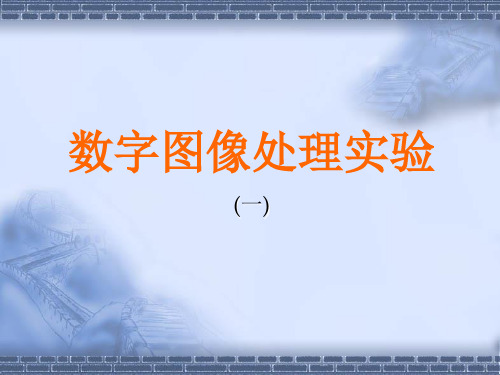
3)存储该图像(文件名用同学们的本名); 4)、制作标准像的硬拷贝;打印两张,一张
上交(附在实验报告中),一张自己保留;
五、撰写实验报告 1)、实验目的叙述; 2)、实验环境描述; 3)、实验项目及内容; 4)、操作步骤详细描述;包括:系统的激 活方法,菜单的运用等;
5)、记录实验结果。 6)、基本原理介绍; 7)、实验现象描述; 8)、实验结果分析;
谢谢
软件: 操作系统:WINDOWS XP 应用软件: 数字图像处理演示软件。
三、实验内容:
1)、图像信息获取; 2)、图像存储; 3)、观察直方图均衡化处理的效果; 4)、观察图像边缘增强处理效果; 5)、拍摄自己的标准像。
四、实验步骤: 1、图像信息的获取: 1)、激活软件; 2)、调整摄像机的光圈和聚焦,
数字图像处理实验
(一)
一、实验目的
1)、了解“数字图像处理系统”的基本组 成结构;
2)、掌握微型数字图像处理系统的基本 操作方法;
3)、体验主要数字图像处理内容的效果。
二、实验的软、硬件平台:
硬件: 微型图像处理系统, 包括:主机, PC机; 摄像机:Logitech 130万像素, 分辨率:640×480 最高分辨率:1280×960 手动聚焦调整.
摄取一张明暗合适的图像;
ห้องสมุดไป่ตู้
3)、存储图像;
4)、调出该图像,验证是否成功存储了该 图像。
2、观察图像均衡化处理效果 1)、激活图像处理软件; 2)、调整摄像机光圈,摄取一张偏暗的图像 并存储该图像;
3)、调用演示程序中的直方图统计功 能,观察直方图形状;
4)、调用直方图均衡化处理功能,观察 处理结果,同时调用直方图统计功 能,观察直方图形状;
数字图像处理四个实验
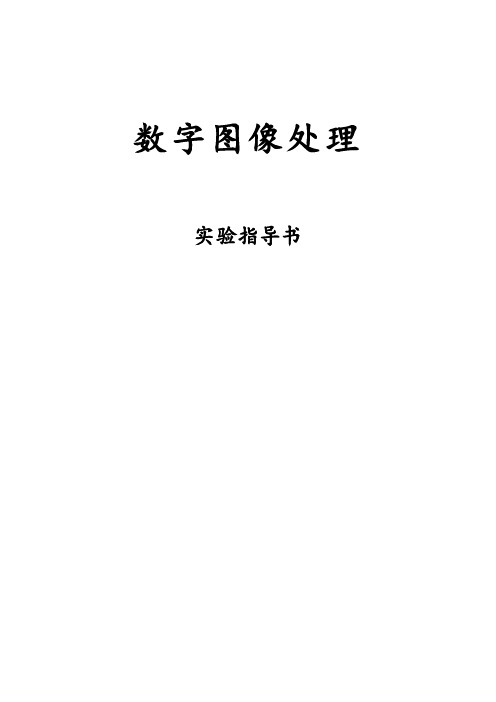
数字图像处理实验指导书目录实验一MATLAB数字图像处理初步实验二图像的代数运算实验三图像增强-空间滤波实验四图像分割实验五形态学运算3实验一 MATLAB数字图像处理初步一、实验目的与要求1.熟悉及掌握在MATLAB中能够处理哪些格式图像。
2.熟练掌握在MATLAB中如何读取图像。
3.掌握如何利用MATLAB来获取图像的大小、颜色、高度、宽度等等相关信息。
4.掌握如何在MATLAB中按照指定要求存储一幅图像的方法。
5.图像间如何转化。
二、实验原理及知识点1、数字图像的表示和类别一幅图像可以被定义为一个二维函数f(x,y),其中x和y是空间(平面)坐标,f 在任何坐标处(x,y)处的振幅称为图像在该点的亮度。
灰度是用来表示黑白图像亮度的一个术语,而彩色图像是由单个二维图像组合形成的。
例如,在RGB彩色系统中,一幅彩色图像是由三幅独立的分量图像(红、绿、蓝)组成的。
因此,许多为黑白图像处理开发的技术适用于彩色图像处理,方法是分别处理三副独立的分量图像即可。
图像关于x和y坐标以及振幅连续。
要将这样的一幅图像转化为数字形式,就要求数字化坐标和振幅。
将坐标值数字化成为取样;将振幅数字化成为量化。
采样和量化的过程如图1所示。
因此,当f的x、y分量和振幅都是有限且离散的量时,称该图像为数字图像。
作为MATLAB基本数据类型的数值数组本身十分适于表达图像,矩阵的元素和图像的像素之间有着十分自然的对应关系。
图1 图像的采样和量化根据图像数据矩阵解释方法的不同,MA TLAB把其处理为4类:亮度图像(Intensity images)二值图像(Binary images)索引图像(Indexed images)RGB图像(RGB images)(1) 亮度图像一幅亮度图像是一个数据矩阵,其归一化的取值表示亮度。
若亮度图像的像素都是uint8类或uint16类,则它们的整数值范围分别是[0,255]和[0,65536]。
数字图像处理课程内容及要求
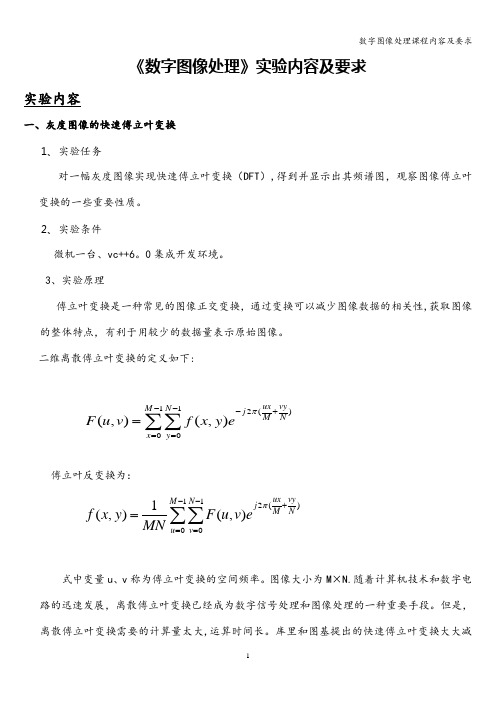
《数字图像处理》实验内容及要求实验内容一、灰度图像的快速傅立叶变换1、 实验任务对一幅灰度图像实现快速傅立叶变换(DFT ),得到并显示出其频谱图,观察图像傅立叶变换的一些重要性质。
2、 实验条件微机一台、vc++6。
0集成开发环境。
3、实验原理傅立叶变换是一种常见的图像正交变换,通过变换可以减少图像数据的相关性,获取图像的整体特点,有利于用较少的数据量表示原始图像。
二维离散傅立叶变换的定义如下:112()00(,)(,)ux vy M N j M Nx y F u v f x y eπ---+===∑∑傅立叶反变换为:112()001(,)(,)ux vy M N j M Nu v f x y F u v eMNπ--+===∑∑式中变量u 、v 称为傅立叶变换的空间频率。
图像大小为M ×N.随着计算机技术和数字电路的迅速发展,离散傅立叶变换已经成为数字信号处理和图像处理的一种重要手段。
但是,离散傅立叶变换需要的计算量太大,运算时间长。
库里和图基提出的快速傅立叶变换大大减少了计算量和存储空间,因此本实验利用快速傅立叶变换来得到一幅灰度图像的频谱图。
快速傅立叶变换的基本思路是把序列分解成若干短序列,并与系数矩阵元素巧妙结合起来计算离散傅立叶变换.若按照奇偶序列将X(n)进行划分,设:()(2)()(21)g n x n h n x n =⎧⎨=+⎩ (n=0,1,2, (12)-)则一维傅立叶变换可以改写成下面的形式:1()()N mnNn X m x n W -==∑11220()()N N mn mnN N n n g n W h n W --===+∑∑ 1122(2)(21)(2)(21)NN m n m n N N n n x n W x n W --+===++∑∑1122022(2)(21)NN mn mn mN N N n n x n W x n W W --===++∑∑ =G(m)+mN W H(m)因此,一个求N 点的FFT 可以转换成两个求2N点的 FFT 。
数字图像处理三试验要求1理解图像增强恢复退化等概念
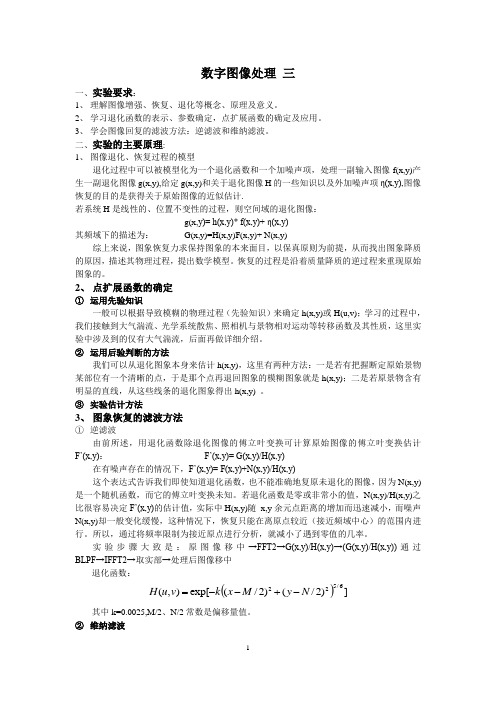
数字图像处理 三一、实验要求:1、 理解图像增强、恢复、退化等概念、原理及意义。
2、 学习退化函数的表示、参数确定,点扩展函数的确定及应用。
3、 学会图像回复的滤波方法:逆滤波和维纳滤波。
二、实验的主要原理:1、 图像退化、恢复过程的模型退化过程中可以被模型化为一个退化函数和一个加噪声项,处理一副输入图像f(x,y)产生一副退化图像g(x,y),给定g(x,y)和关于退化图像H 的一些知识以及外加噪声项η(x,y),图像恢复的目的是获得关于原始图像的近似估计.若系统H 是线性的、位置不变性的过程,则空间域的退化图像:g(x,y)= h(x,y)* f(x,y)+ η(x,y)其频域下的描述为: G(x,y)=H(x,y)F(x,y)+ N(x,y)综上来说,图象恢复力求保持图象的本来面目,以保真原则为前提,从而找出图象降质的原因,描述其物理过程,提出数学模型。
恢复的过程是沿着质量降质的逆过程来重现原始图象的。
2、 点扩展函数的确定① 运用先验知识一般可以根据导致模糊的物理过程(先验知识)来确定h(x,y)或H(u,v);学习的过程中,我们接触到大气湍流、光学系统散焦、照相机与景物相对运动等转移函数及其性质,这里实验中涉及到的仅有大气湍流,后面再做详细介绍。
② 运用后验判断的方法我们可以从退化图象本身来估计h(x,y),这里有两种方法:一是若有把握断定原始景物某部位有一个清晰的点,于是那个点再退回图象的模糊图象就是h(x,y);二是若原景物含有明显的直线,从这些线条的退化图象得出h(x,y) 。
③ 实验估计方法3、 图象恢复的滤波方法① 逆滤波由前所述,用退化函数除退化图像的傅立叶变换可计算原始图像的傅立叶变换估计F’(x,y): F’(x,y)= G(x,y)/H(x,y)在有噪声存在的情况下,F’(x,y)= F(x,y)+N(x,y)/H(x,y)这个表达式告诉我们即使知道退化函数,也不能准确地复原未退化的图像,因为N(x,y)是一个随机函数,而它的傅立叶变换未知。
数字图像处理实验报告
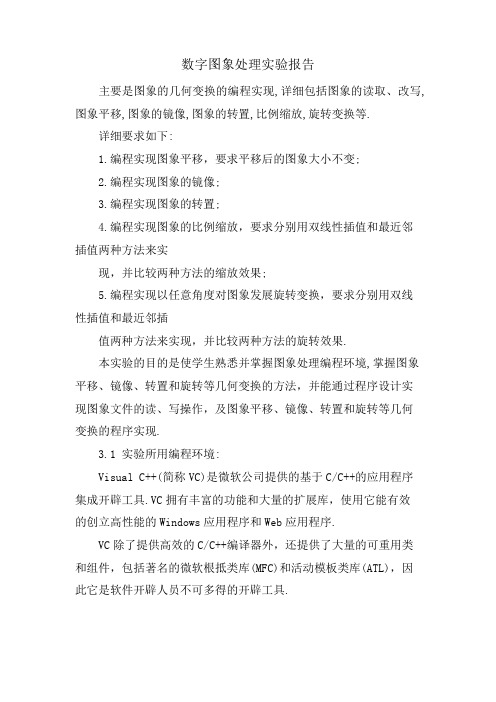
数字图象处理实验报告主要是图象的几何变换的编程实现,详细包括图象的读取、改写,图象平移,图象的镜像,图象的转置,比例缩放,旋转变换等.详细要求如下:1.编程实现图象平移,要求平移后的图象大小不变;2.编程实现图象的镜像;3.编程实现图象的转置;4.编程实现图象的比例缩放,要求分别用双线性插值和最近邻插值两种方法来实现,并比较两种方法的缩放效果;5.编程实现以任意角度对图象发展旋转变换,要求分别用双线性插值和最近邻插值两种方法来实现,并比较两种方法的旋转效果.本实验的目的是使学生熟悉并掌握图象处理编程环境,掌握图象平移、镜像、转置和旋转等几何变换的方法,并能通过程序设计实现图象文件的读、写操作,及图象平移、镜像、转置和旋转等几何变换的程序实现.3.1 实验所用编程环境:Visual C++(简称VC)是微软公司提供的基于C/C++的应用程序集成开辟工具.VC拥有丰富的功能和大量的扩展库,使用它能有效的创立高性能的Windows应用程序和Web应用程序.VC除了提供高效的C/C++编译器外,还提供了大量的可重用类和组件,包括著名的微软根抵类库(MFC)和活动模板类库(ATL),因此它是软件开辟人员不可多得的开辟工具.VC丰富的功能和大量的扩展库,类的重用特性以及它对函数库、DLL库的支持能使程序更好的模块化,并且通过向导程序大大简化了库资源的使用和应用程序的开辟,正由于VC具有明显的优势,于是我选择了它来作为数字图象几何变换的开辟工具.在本程序的开辟过程中,VC的核心知识、消息映射机制、对话框控件编程等都得到了生动的表达和灵便的应用.3.2 实验处理的对象:256色的BMP(BIT MAP )格式图象BMP(BIT MAP )位图的文件构造:详细组成图: BITMAPFILEHEADER位图文件头(只用于BMP文件) bfType=”BM” bfSize bfReserved1bfReserved2bfOffBitsbiSizebiWidthbiHeightbiPlanesbiBitCountbiCompressionbiSizeImagebiXPelsPerMeterbiYPelsPerMeterbiClrUsedbiClrImportant单色DIB有2个表项16色DIB有16个表项或者更少256色DIB有256个表项或者更少真彩色DIB没有调色板每一个表项长度为4字节(32位)像素按照每行每列的顺序罗列每一行的字节数必须是4的整数倍BITMAPINFOHEADER 位图信息头 Palette 调色板 DIBPixels DIB图象数据1. BMP文件组成BMP文件由文件头、位图信息头、颜色信息和图形数据四部份组成.2. BMP文件头BMP文件头数据构造含有BMP文件的类型(必须为BMP)、文件大小(以字节为单位)、位图文件保存字(必须为0)和位图起始位置(以相对于位图文件头的偏移量表示)等信息.3. 位图信息头BMP位图信息头数据用于说明位图的尺寸(宽度,高度等都是以像素为单位,大小以字节为单位, 水平和垂直分辨率以每米像素数为单位) ,目标设备的级别,每一个像素所需的位数, 位图压缩类型(必须是 0)等信息.4. 颜色表颜色表用于说明位图中的颜色,它有假设干个表项,每一个表项是一个RGBQUAD类型的构造,定义一种颜色.详细包含蓝色、红色、绿色的亮度(值范围为0-255)位图信息头和颜色表组成位图信息5. 位图数据位图数据记录了位图的每一个像素值,记录顺序是在扫描行内是从左到右,扫描行之间是从下到上.Windows一个扫描行所占的字节数必须是 4的倍数(即以long为单位),缺乏的以0填充.3.3 BMP(BIT MAP )位图的显示:①普通显示方法:1. 申请内存空间用于存放位图文件2. 位图文件读入所申请内存空间中3. 在函数中用创立显示用位图, 用函数创立兼容DC,用函数选择显示删除位图但以上方法的缺点是: 1)显示速度慢; 2) 内存占用大; 3) 位图在缩小显示时图形失真大,(可通过安装字体平滑软件来解决); 4) 在低颜色位数的设备上(如256显示模式)显示高颜色位数的图形(如真彩色)图形失真严重.②BMP位图缩放显示 :用视频函数来显示位图,内存占用少,速度快,而且还可以对图形发展淡化(Dithering )处理.淡化处理是一种图形算法,可以用来在一个支持比图象所用颜色要少的设备上显示彩色图象.BMP位图显示方法如下:1. 翻开视频函数,普通放在在构造函数中2. 申请内存空间用于存放位图文件3. 位图文件读入所申请内存空间中4. 在 函数中 显示位图5. 关闭视频函数 ,普通放在在析构函数中以上方法的优点是: 1)显示速度快; 2) 内存占用少; 3) 缩放显示时图形失真小,4) 在低颜色位数的设备上显示高颜色位数的图形图形时失真小; 5) 通过直接处理位图数据,可以制作简单动画.3.4 程序中用到的访问函数Windows支持一些重要的DIB访问函数,但是这些函数都还没有被封装到MFC中,这些函数主要有:1. SetDIBitsToDevice函数:该函数可以直接在显示器或者打印机上显示DIB. 在显示时不发展缩放处理.2. StretchDIBits函数:该函数可以缩放显示DIB于显示器和打印机上.3. GetDIBits函数:还函数利用申请到的内存,由GDI位图来构造DIB.通过该函数,可以对DIB的格式发展控制,可以指定每一个像素颜色的位数,而且可以指定是否发展压缩.4. CreateDIBitmap函数:利用该函数可以从DIB出发来创立GDI位图.5. CreateDIBSection函数:该函数能创立一种特殊的DIB,称为DIB项,然后返回一个GDI位图句柄.6. LoadImage函数:该函数可以直接从磁盘文件中读入一个位图,并返回一个DIB句柄.7. DrawDibDraw函数:Windows提供了窗口视频(VFW)组件,Visual C++支持该组件.VFW中的DrawDibDraw函数是一个可以替代StretchDIBits的函数.它的最主要的优点是可以使用颤动颜色,并且提高显示DIB的速度,缺点是必须将VFW代码连接到进程中.3.5 图象的几何变换图象的几何变换,通常包括图象的平移、图象的镜像变换、图像的转置、图象的缩放和图象的旋转等.实验目的:本实验内容旨在让学生通过用VC等高级语言编写数字图象处理的一些根本算法程序,来稳固和掌握图象处理技术的根本技能,提高实际动手能力,并通过实际编程了解图象处理软件的实现的根本原理。
数字图像处理处理大作业实验报告
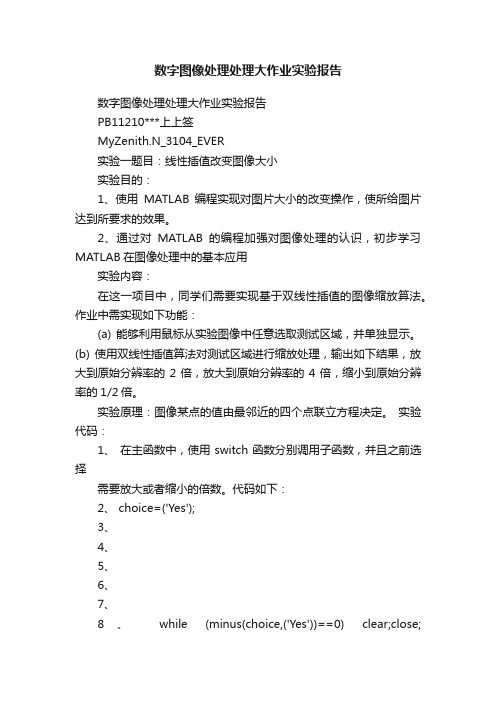
数字图像处理处理大作业实验报告数字图像处理处理大作业实验报告PB11210***上上签MyZenith.N_3104_EVER实验一题目:线性插值改变图像大小实验目的:1、使用MATLAB编程实现对图片大小的改变操作,使所给图片达到所要求的效果。
2、通过对MATLAB的编程加强对图像处理的认识,初步学习MATLAB在图像处理中的基本应用实验内容:在这一项目中,同学们需要实现基于双线性插值的图像缩放算法。
作业中需实现如下功能:(a) 能够利用鼠标从实验图像中任意选取测试区域,并单独显示。
(b) 使用双线性插值算法对测试区域进行缩放处理,输出如下结果,放大到原始分辨率的2倍,放大到原始分辨率的4倍,缩小到原始分辨率的1/2倍。
实验原理:图像某点的值由最邻近的四个点联立方程决定。
实验代码:1、在主函数中,使用switch函数分别调用子函数,并且之前选择需要放大或者缩小的倍数。
代码如下:2、 choice=('Yes');3、4、5、6、7、8、while (minus(choice,('Yes'))==0) clear;close;F=imread('monarch.bmp'); I=imcrop(F); BR=I(:,:,1); BG=I(:,:,2); BB=I(:,:,3); [rows,cols]=size(BR);K = sqrt(str2double(inputdlg('·?±???', 'INPUT scalefactor', 1, {'2'})));9、 width = K * rows;10、 height = K * cols;11、12、13、14、 widthScale = rows/width;15、 heightScale = cols/height;16、17、 for x = 1:width-2for y = 1:height-218、 X = x * widthScale;Y = y * heightScale;19、20、 if (X/double(uint16(X)) == 1.0) && (Y/double(uint16(Y)) == 1.0) 21、 dstBR(x,y) = BR(int16(X),int16(Y));dstBG(x,y) = BG(int16(X),int16(Y));22、 dstBB(x,y) = BB(int16(X),int16(Y)); 23、 else24、 a = double(uint16(X));25、 b = double(uint16(Y));26、27、28、29、30、BRx11 = double(BR(a,b)); BRx12 = double(BR(a,b+1)); BRx21 = double(BR(a+1,b)); BRx22 = double(BR(a+1,b+1));31、32、 BGx11 = double(BG(a,b));33、 BGx12 = double(BG(a,b+1));34、 BGx21 = double(BG(a+1,b));35、 BGx22 = double(BG(a+1,b+1));36、37、38、39、40、BBx11 = double(BB(a,b)); BBx12 = double(BB(a,b+1)); BBx21 = double(BB(a+1,b)); BBx22 = double(BB(a+1,b+1));41、42、 w1 = (b+1-Y) * (a+1-X); 43、 w2 = (Y-b) * (a+1-X);w3 = (b+1-Y) * (X-a);44、 w4 = (Y-b) * (X-a); 45、 dstBR(x,y) = uint8( BRx11 * w1 + BRx12 * w2 + BRx21* w3 + BRx22 * w4 );46、 dstBG(x,y) = uint8( BGx11 * w1 + BGx12 * w2 + BGx21* w3 + BGx22 * w4 );47、 dstBB(x,y) = uint8( BBx11 * w1 + BBx12 * w2 + BBx21* w3 + BBx22 * w4 );48、 end49、 end50、 end51、52、53、54、55、56、57、OUT(:,:,1)=dstBR; OUT(:,:,2)=dstBG; OUT(:,:,3)=dstBB;imshow(I); figure; imshow(OUT);58、59、60、61、62、options.Interpreter = 'tex'; options.Default = 'Cancel'; choice = questdlg('??·','????','Yes','No',options); end实验结果:1、选择缩放倍数:2、所选择的图像源文件如下:3、用鼠标标定所需要进行缩放的区域:4、程序正常运行后缩放效果:4倍放大5、程序正常运行后缩放效果:2倍放大6、程序正常运行后的缩放效果:缩小一倍实验二题目:高斯滤波及中值滤波处理人为添加的椒盐噪声和高斯噪声实验目的:1、对所给定的图像使用MATLAB添加高斯噪声和椒盐噪声;2、再用MATLAB程序实现中值滤波和高斯滤波;3、计算所得到结果图像的PSNR,对它们进行分析与比较,从而理解各种滤波方法的优点与特性。
DSP数字图像处理实验课设
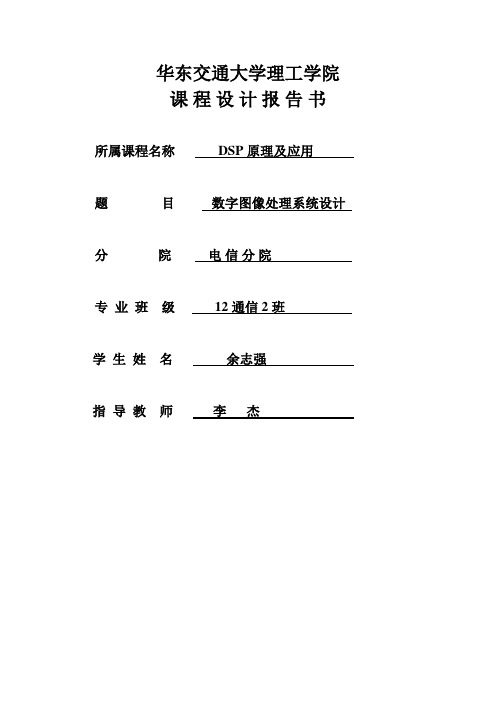
华东交通大学理工学院课程设计报告书所属课程名称DSP原理及应用题目数字图像处理系统设计分院电信分院专业班级 12通信2班学生姓名余志强指导教师李杰目录第一章课程设计内容及要求第二章程序设计原理2.1数字图象处理基本原理2.2数字图像处理常用方法2.3图象灰度处理的基本原理2.4图象的反色原理和实现2.5灰度图象二值化原理及意义第三章程序设计步骤第四章总结第一章课程设计内容及要求一、设计内容1了解数字图象处理的基本原理2 学习灰度图象反色处理技术3 学习灰度图象二值化处理技术第二章程序设计原理2、1数字图像处理的基本原理数字图像处理是指将图像信号转换成数字信号并利用计算机对其进行处理的过程。
图像处理最早出现于 20 世纪 50 年代,当时的电子计算机已经发展到一定水平,人们开始利用计算机来处理图形和图像信息。
数字图像处理作为一门学科大约形成于 20 世纪 60 年代初期。
早期的图像处理的目的是改善图像的质量,它以人为对象,以改善人的视觉效果为目的。
图像处理中,输入的是质量低的图像,输出的是改善质量后的图像,常用的图像处理方法有图像增强、复原、编码、压缩等。
2、2 数字图像处理常用方法:1 )图像变换:由于图像阵列很大,直接在空间域中进行处理,涉及计算量很大。
因此,往往采用各种图像变换的方法,如傅立叶变换、沃尔什变换、离散余弦变换等间接处理技术,将空间域的处理转换为变换域处理,不仅可减少计算量,而且可获得更有效的处理(如傅立叶变换可在频域中进行数字滤波处理)。
目前新兴研究的小波变换在时域和频域中都具有良好的局部化特性,它在图像处理中也有着广泛而有效的应用。
2 )图像编码压缩:图像编码压缩技术可减少描述图像的数据量(即比特数),以便节省图像传输、处理时间和减少所占用的存储器容量。
压缩可以在不失真的前提下获得,也可以在允许的失真条件下进行。
编码是压缩技术中最重要的方法,它在图像处理技术中是发展最早且比较成熟的技术。
数字图像处理实验内容与要求
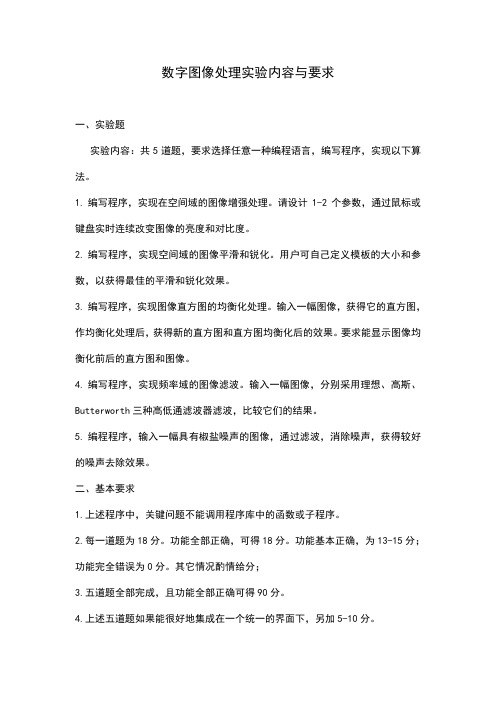
数字图像处理实验内容与要求
一、实验题
实验内容:共5道题,要求选择任意一种编程语言,编写程序,实现以下算法。
1.编写程序,实现在空间域的图像增强处理。
请设计1-2个参数,通过鼠标或键盘实时连续改变图像的亮度和对比度。
2.编写程序,实现空间域的图像平滑和锐化。
用户可自己定义模板的大小和参数,以获得最佳的平滑和锐化效果。
3.编写程序,实现图像直方图的均衡化处理。
输入一幅图像,获得它的直方图,作均衡化处理后,获得新的直方图和直方图均衡化后的效果。
要求能显示图像均衡化前后的直方图和图像。
4.编写程序,实现频率域的图像滤波。
输入一幅图像,分别采用理想、高斯、Butterworth三种高低通滤波器滤波,比较它们的结果。
5.编程程序,输入一幅具有椒盐噪声的图像,通过滤波,消除噪声,获得较好的噪声去除效果。
二、基本要求
1.上述程序中,关键问题不能调用程序库中的函数或子程序。
2.每一道题为18分。
功能全部正确,可得18分。
功能基本正确,为13-15分;功能完全错误为0分。
其它情况酌情给分;
3.五道题全部完成,且功能全部正确可得90分。
4.上述五道题如果能很好地集成在一个统一的界面下,另加5-10分。
- 1、下载文档前请自行甄别文档内容的完整性,平台不提供额外的编辑、内容补充、找答案等附加服务。
- 2、"仅部分预览"的文档,不可在线预览部分如存在完整性等问题,可反馈申请退款(可完整预览的文档不适用该条件!)。
- 3、如文档侵犯您的权益,请联系客服反馈,我们会尽快为您处理(人工客服工作时间:9:00-18:30)。
1基于形态学运算的星空图像分割 主要内容:在获取星图像的过程中,由于某些因素的影响,获得的星图像存在噪声,而且星图像的背景经常是不均匀的,为星图像的分割造成了极大的困难。
膨胀和腐蚀是形态学的两个基本运算。
用形态学运算对星图像进行处理,补偿不均匀的星图像背景,然后进行星图像的阈值分割。
要求:1> 图像预处理:对原始星空图像进行滤波去噪处理; 2> 对去噪后的图像进行形态学运算处理;3> 选取自适应阈值对形态学运算处理后的图像进行二值化; 4> 显示每步处理后的图像;5> 对经过形态学处理后再阈值的图像和未作形态学处理后再阈值的图像进行对比分析。
待分割图像 直接分割图像 处理后的分割图像2基于数字图像处理的印刷电路板智能检测方法 主要内容:通过对由相机实时获取的印刷电路板图像进行焊盘识别,从而提高电子元件的贴片质量,有效提高电路板的印刷效率。
要求:1> 图像预处理:将原始彩色印刷电路板图像转成灰度图像,对灰度图像进行背景平滑和滤波去噪; 2> 对去噪后的图像进行图像增强处理,增强边缘提取的效果。
3> 对增强后的图像进行边缘提取(至少两种以上的边缘提取算法); 4> 显示每步处理后的图像(原始电路板图像可自行查找); 5> 图像处理后要求能对每个焊盘进行边缘提取,边缘清晰。
3静止背景下的移动目标视觉监控 主要内容:基于视觉的人的运动分析最有前景的潜在应用之一是视觉监控。
视觉监控系统的需求主要来自那些对安全要求敏感的场合,如银行、商店、停车场、军事基地等。
通过对静止背景下的目标识别,来提醒监测人员有目标出现。
要求:1>对原始参考图和实时图像进行去噪处理;2>对去噪后的两幅图像进行代数运算,找出目标所在位置,提取目标,并将背景置黑;3> 判断目标大小,若目标超过整幅图像的一定比例时,说明目标进入摄像保护区域,系统对监测人员进行提示(提示方式自选)。
4>显示每步处理后的图像;5>分析此种图像监控方式的优缺点。
背景目标出现目标提取4车牌识别图像预处理技术主要内容:车辆自动识别涉及到多种现代学科技术,如图像处理、模式识别与人工智能、计算机视觉、光学、机械设计、自动控制等。
汽车作为人类生产、生活中的重要工具被广泛的使用,实现自动采集车辆信息和智能管理的车牌自动识别系统具有十分重要的意义: 要求:1>对原始车牌图像做增强处理;2>对增强后的彩色图像进行灰度变换;3>对灰度图像进行直方图均衡处理;4>选取自适应的阈值,对图像做二值化处理;5>显示每步处理后的图像;6>分析此种图像预处理的优缺点及改进措施,简要叙述车牌字符识别方法原始车牌图像处理后的车牌图像5医学细胞图像细胞分割图像增强算法研究主要内容:医学图象处理利用多种方法对各种图像数据进行处理,以期得到更好的显示效果以便医生根据细胞的外貌进行病变分析。
要求:1>通过对图像的灰度变换调整改变细胞图像的灰度,突出感兴趣的细胞和细胞核区域。
2>通过直方图修改技术得到均衡化或规定化等不同的处理效果。
3>采用有效的图像平滑方法对细胞图像进行降噪处理,消除图像数字化和传输时所混入的噪声,提高图像的视觉效果。
4>利用图像锐化处理突出细胞的边缘信息,加强细胞的轮廓特征。
5>显示每步处理图像,分析此种细胞分割图像预处理方法的优缺点。
原始细胞图像图像处理后的细胞图像6瓶子灌装流水线检测是否液体灌装满瓶体当饮料瓶子在罐装设备后要进行液体的检测,即:进行判断瓶子灌装流水线是否灌装满瓶体的检测,如液面超过瓶颈的位置,则装满,否则不满,如果不满则灌装液体不合格,需重新进行灌装。
具体要求:1)将原进行二值化2)二值化后的图像若不好,将其滤波再进行膨胀处理,并重新进行二值化3)将图像标记连通域并进行面积计算,找出不符合要求的标记块4)将不合格的图像进行提取,并记录不合格率5)显示所有的图像,对经过处理后的图像和未作处理后的图像进行对比分析。
7对加噪声的图像进行频域低通和高通滤波,并针对其显示图像进行对比分析具体要求:1、对源图像进行空域到频域的变换2、进行频域的高斯低通滤波(取D0为10,20,40,80)3、频域的高斯高通滤波(取D0为10,20,40,80)4、频域的布特沃斯低通滤波(取D0为10,20,40,80,n为2)5、频域的布特沃斯低通滤波(取D0为10,20,40,80,n为2)显示所有的图像,对图像滤波的结果进行比较,包括同种滤波器不同D0处理图像的比较以及不同滤波器之间的比较。
(下图为D0取为20的结果)8请根据所学过的图象分析方法,将飞机边界进行提取,并叠加在原图上具体要求:将RGB图像(图A)转换成灰度模式图像(图B),再将其进行二值化(图C),所得图像进行闭运算,去掉暗点和圆角(图D),最后对图像进行边界提取并叠加在原图上(图E)。
显示所有的图像,对经过处理后的图像和未作处理后的图像进行对比分析。
9基于数字图像处理的森林火灾识别方法研究主要内容:基于摄像机摄取的视频图像对现场进行火灾的自动探测、监视,同时将摄得的图像,利用各种图像处理技术不断进行图像处理和分析,通过早期火灾的图像变化特征来探测火灾是否发生。
测试要求:首先从彩色摄像机获取视频流图像,并转换成BMP格式图像,先判断图像中有红色区域存在。
l)火灾图像预处理,包括图像抽样、图像分割、图像灰度化、二值化、图像平滑处理;2)研究火焰目标的特征提取方法(l)轮廓特征提取:该模块主要功能为提取火焰轮廓上的尖点特征和圆形度。
在火焰轮廓特征图中,从下至上从左至右逐点扫描,将火焰的边缘编成链码。
当链码在一定步数内,出现一次有效上升和一次有效下降时,我们就得到一个尖角。
(2)颜色特征提取:火焰一般从焰心到外焰其颜色应从白色到黄色再向红色移动,在图像中表现为像素值的变化不明显,可以用图像像素方差值来反映这种变化。
(3)动态特征提取:火焰在燃烧的过程中,它的面积和质心在不断的变化,通过质心的变化来判断火势的大小10、采用数字图像处理技术实现对玉米种子表面裂纹的识别和检测。
玉米籽粒产生裂纹后会影响淀粉出率,不能用来加工玉米片等食品,同时在储存时裂纹粒吸湿性强,易于引起发热和遭受害虫及霉菌的侵袭,对于种子还会影响到种子的发芽率,即使作为饲料原料也必须严格限制玉米的裂纹率,对玉米籽粒图像通过边缘提取后结合利用籽粒的形态学特征实现了裂纹的自动提取和测量测试要求:1)采用水平和垂直边缘检测算子处理得到裂纹、种子边界和噪声等边缘信息;2)通过玉米籽粒的形态特征寻找其尖端位置并使用图像代数运算的方法去除大部分非裂纹信息;3)根据裂纹的长度和位置特征提取得到裂纹,并计算裂纹的绝对长度和相对长度。
11对图像的文字区域检测研究主要内容:针对国内外对图像文字区域提取方法现状中存在的问题,提出一种新的方法。
可以使文字区域提取的准确率提高,进而可以实现对复杂背景的图像也能较好地实现文字区域与背景区域的分离。
要求:1、输入彩色图像;2、将彩色图像转化为灰度图像并对灰度图像进行纵向边缘检测;3、通过等值进行分割、动态列分割、相邻矩形区域合并确定候选文字区域;4、候选文字区域灰度直方图分析;5、根据二值图像生成的四邻域的几何形状特征确定最终文字区域实现效果:要求图片:12实现对针织物疵点检测的研究主要内容:通过对多种疵点检测算法进行分析比较,提出一种可以成功对针织物疵点进行检测识别的方法。
要求:1、二值化处理2、直方图均衡化3、针织物图像分割窗口的确定4、特征值提取5、将疵点区域准确的分割出来实现的效果要求图片:13实现对谷物颗粒计数的研究主要要求:提出一种方法,使操作简单,图像清晰度高的识别出谷物颗粒,从而达到可以数出谷物颗粒的个数。
要求:1、将谷物图像进行灰度化处理;2、进行去除噪声处理;3、将灰度图像转化为二值图像;4、通过连通性,计算谷物的颗粒数。
实现效果:左图为原始图像,右图为分割提取的目标14计算原料乳细菌数的研究主要要求:提出一种方法,操作简单,可以准备识别出一幅图像中的细菌数量。
要求:1、将获取到得图像进行预处理2、通过检验算法找到细菌并进行定位和滤波去噪3、将单个细菌从所在的图像区域中分离出来4、通过识别计算出细菌的总数实现效果:左图为原始图像,右图为分割提取的目标15机器视觉图像的目标与背景的分割与提取主要要求:对输入的图像可以达到目标和背景的分割要求:1、将已知图像进行消噪处理2、对彩色图像进行目标和背景分析3、通过阈值法将图像进行分割4、确定目标的位置实现效果:左图为原始图像,右图为分割提取的目标要求图片:16基于图像的一维条码识别条码技术是在计算机技术的实践应用中产生并发展起来的、并被广泛应用于邮政、图书管理、仓储、工业生产、交通等领域的一种自动识别技术,它具有输入速度快、识别度高、成本低廉、可靠性强等优点,在当今的自动识别技术中占有非常重要的地位。
条码是由一组有特定顺序排列的条、空以及特有的字符标记组成的,这些条和空组成的图像标记表达一定的信息,并能够用相应的设备读取识别,并转换成能够使计算机识别的二进制和十进制数据信息。
通常对于一种物品,它的编码规则是唯一的参考步骤:1)中值滤波2)二值化,先进行灰度值统计,求阈值,二值化图片3)边沿检测4)条码识别,垂直投影原理,求个条空的宽度,识别码字要求:能从图像读出1维条码的码字信息17利用数字图像处理技术测量几何尺寸针对传统接触式尺寸测量方法的缺点,探讨利用数字图像处理技术进行几何尺寸测量的方法,为产品的尺寸测量提供实时、快速、有效、经济的测量途径.给出了利用数字图像处理技术进行非接触式尺寸测量的方法,并从理论和实践上证明该方法的可行性和正确性.参考步骤:1)图像预处理使用平滑处理的方法,其主要目的是减少噪声.2)边缘轮廓的提取,边缘算子检测法,阈值计算法3)尺寸的计算,系统标定精度直接关系到测量精度要求:能从图像读出人物的肩宽的实际尺寸18破损图像的复原技术随着多媒体技术的发展,计算机网络技术的广泛应用和宽带信息网的建立,信息在人们的工作、学习和生活中发挥越来越重要的作用,其中最直接、最主要的信息是图像信息。
在各类图像系统中,由于图像的传送和转换,如成像、复制、扫描、传输、显示等,总要造成图像的降质,典型的表现为图像模糊、失真、有噪声等。
而在众多的应用领域中,又需要清晰的、高质量的图像,因此,为了抑制噪声,改善图像质量,复原图像具有非常重要的意义。
在数字图像处理领域,图像复原一直是最重要、最基本的研究课题之一,具有重要的理论价值和实际意义。
1)数字图像的表示,图像的采样和量化2)图像的灰度直方图3)图像的噪声,图像的均值滤波4)基于图像域的傅里叶图像复原算法要求:能从破损图像获得清晰的、高质量的图像19图像的特征提取特征提取是计算机视觉和图像处理中的一个概念。
